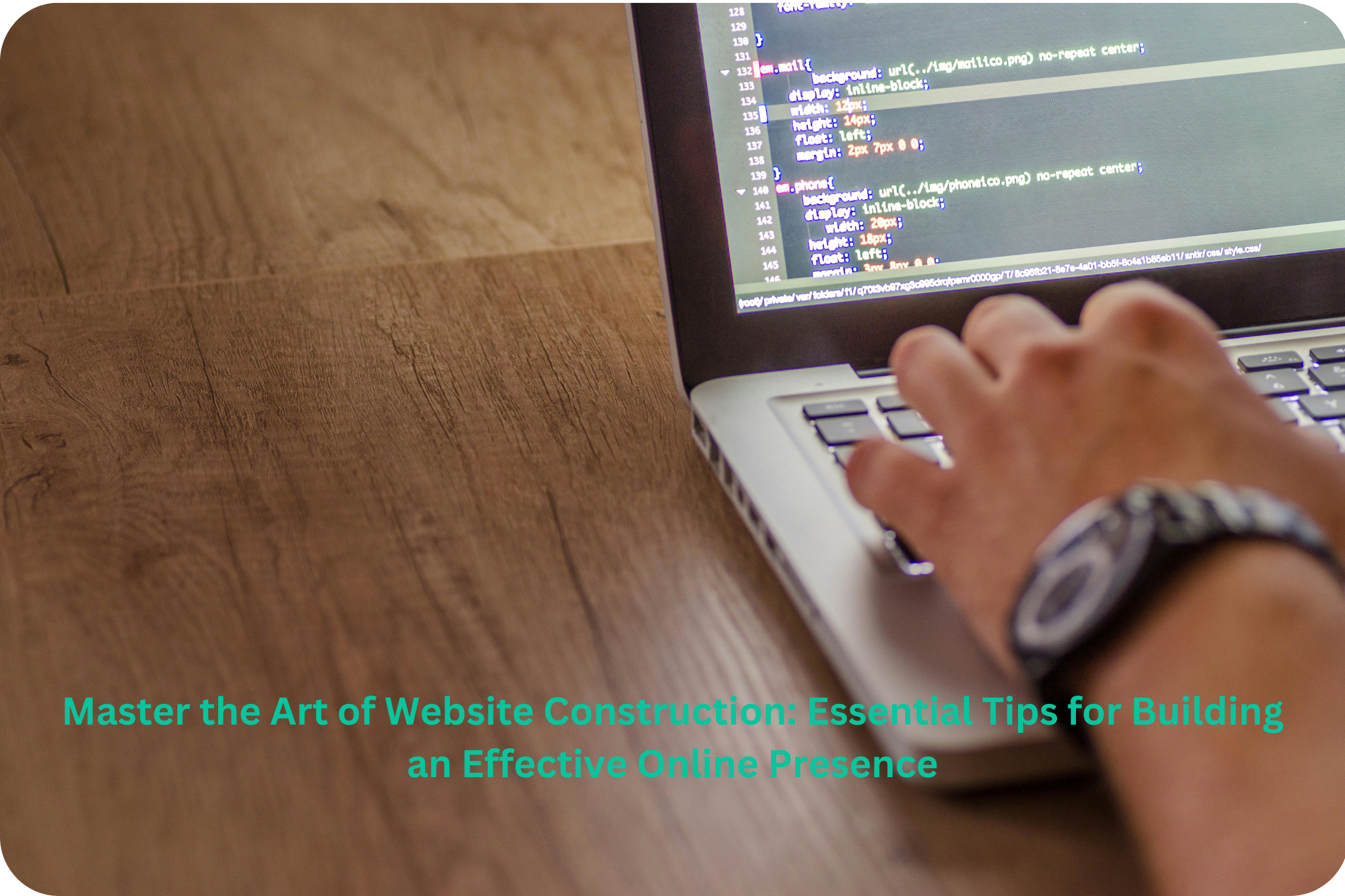Are you ready to establish a formidable online presence? Building a website is a crucial step towards reaching a wider audience and achieving your goals. Whether you’re a business owner, a blogger, or an aspiring entrepreneur, this informative guide will equip you with the essential tips and techniques to construct a website that truly stands out. From selecting the right domain name to optimizing your site for search engines, we’ll delve into the intricacies of website construction and help you create a captivating online platform. Let’s embark on this exciting journey and unlock the secrets of building a successful website!
Choosing the Perfect Domain Name
When it comes to building a website, selecting the right domain name is paramount. Your domain name is essentially the address that people will use to find your website on the internet. It should be memorable, relevant to your brand or niche, and ideally, include relevant keywords.
Consider brainstorming a list of potential domain names that align with your website’s purpose and target audience. Aim for a name that is concise, easy to spell, and devoid of any confusing or unnecessary characters. A domain name that reflects your brand and resonates with your audience can leave a lasting impression and make it easier for visitors to recall and revisit your site.
Key Tips:
- Keep it short and simple
- Include relevant keywords
- Avoid hyphens and numbers
- Choose a domain extension that fits your target audience (.com, .net, .org, etc.)
Remember, your domain name is the foundation of your online presence, so invest time and effort in choosing the perfect one that sets the stage for your website’s success.
Designing an Engaging User Interface
When it comes to website construction, an engaging user interface (UI) is essential for keeping visitors hooked and encouraging them to explore further. A well-designed UI enhances the overall user experience, making it easier for users to navigate your site and find what they’re looking for. Here are some key elements to consider:
1. Intuitive Navigation:
Ensure that your website’s navigation is clear, intuitive, and easy to use. Use a logical structure with well-organized menus and submenus to help visitors effortlessly find the information they need.
2. Appealing Layout:
Choose a visually pleasing layout that aligns with your brand and content. Utilize whitespace effectively to create a clean and uncluttered appearance, allowing important elements to stand out.
3. Consistent Branding:
Consistency is key when it comes to branding. Use consistent colors, fonts, and imagery throughout your website to establish a cohesive and professional look.
4. Responsive Design:
In today’s mobile-centric world, it’s crucial to ensure your website is mobile-friendly and responsive. Optimize your design to adapt seamlessly to different screen sizes, providing a smooth experience across devices.
5. Call-to-Action (CTA) Placement:
Strategically place clear and compelling CTAs throughout your website to guide visitors towards desired actions, such as making a purchase, subscribing to a newsletter, or contacting you.
By paying attention to these UI elements, you can create a visually appealing and user-friendly website that leaves a positive impression on your visitors.
Optimizing Your Website for Search Engines
Building a website is only half the battle; ensuring it is discoverable by search engines is equally important. Here are some key strategies to optimize your website for better search engine visibility:
1. Keyword Research:
Conduct thorough keyword research to identify relevant terms and phrases that your target audience is searching for. Incorporate these keywords naturally into your website’s content, including titles, headings, and meta descriptions.
2. High-Quality Content:
Create valuable and informative content that is relevant to your audience. Aim to provide solutions, answer questions, and offer unique insights. Well-written, engaging content can help establish your website as an authoritative source in your niche.
3. Meta Tags and Descriptions:
Optimize your meta tags and meta descriptions with relevant keywords to provide search engines with a clear understanding of your website’s content. These concise snippets appear in search engine results, influencing click-through rates.
4. Mobile Optimization:
With the majority of internet users accessing websites through mobile devices, optimizing your website for mobile is crucial. Ensure your site is responsive, loads quickly, and has a user-friendly mobile interface.
5. Link Building:
Develop a strong backlink profile by earning high-quality links from reputable websites. This can boost your website’s authority and credibility in the eyes of search engines.
By implementing these optimization strategies, you can increase your website’s visibility in search engine results, driving organic traffic and reaching a wider audience.
Ensuring Website Security and Maintenance
Building a website is not a one-time task; it requires ongoing security measures and regular maintenance to protect your site and provide a smooth user experience. Here are some essential steps to consider:
1. SSL Certificate:
Obtain an SSL certificate to encrypt data transmitted between your website and visitors’ browsers. This not only enhances security but also improves your site’s credibility, as indicated by the “https://” in the URL.
2. Regular Backups:
Regularly back up your website’s files and databases to secure important data. This ensures that you can quickly restore your site in case of any unforeseen issues or data loss.
3. Software Updates:
Stay updated with the latest versions of your website’s CMS (Content Management System), plugins, and themes. These updates often include security patches and bug fixes to protect against vulnerabilities.
4. Strong Passwords:
Use strong, unique passwords for all administrative accounts associated with your website. This reduces the risk of unauthorized access and potential breaches.
5. Regular Audits:
Perform regular security audits to identify and address any vulnerabilities or weaknesses in your website’s infrastructure. This may include checking for outdated plugins, removing unused themes, and implementing additional security measures.
By prioritizing website security and maintenance, you can safeguard your site, protect user data, and maintain a seamless online experience for your visitors.
Measuring Website Performance and Analytics
Building a website is an ongoing process that requires continuous monitoring and analysis. By measuring your website’s performance and analyzing user behavior, you can make data-driven decisions to improve its effectiveness. Here are some key aspects to consider:
1. Website Analytics:
Implement a robust analytics tool like Google Analytics to gain insights into your website’s performance. Track metrics such as page views, bounce rates, conversion rates, and user demographics to understand user behavior and identify areas for improvement.
2. User Engagement:
Monitor user engagement metrics such as time spent on site, average session duration, and the number of pages visited. This data can help you gauge the effectiveness of your content and user experience.
3. Conversion Tracking:
Set up conversion tracking to measure the success of specific actions or goals on your website, such as form submissions, purchases, or newsletter sign-ups. Analyzing conversion data can help you optimize your website for better results.
4. Load Time Optimization:
Regularly monitor your website’s load time using tools like Google PageSpeed Insights. Slow-loading pages can negatively impact user experience and lead to higher bounce rates. Identify and address any performance bottlenecks to ensure optimal site speed.
5. A/B Testing:
Conduct A/B tests to compare different versions of your website or specific elements (such as headlines, images, or call-to-action buttons). Analyze the results to determine which variations perform better and make data-backed decisions for optimization.
By continually measuring and analyzing your website’s performance, you can identify areas that need improvement, refine your strategies, and ultimately enhance the overall user experience.
Building a website is an exciting endeavor that requires careful planning, attention to detail, and ongoing efforts to ensure its success. From choosing the perfect domain name and designing an engaging user interface to optimizing for search engines, securing your site, and measuring performance, there are numerous factors to consider. By following the tips and strategies outlined in this guide, you can construct a website that not only captures attention but also delivers an exceptional user experience. Remember, building a website is a continuous process, so don’t be afraid to adapt, iterate, and improve as you go along. With dedication and the right approach, your website can become a powerful tool to reach your audience, achieve your goals, and establish a strong online presence.

